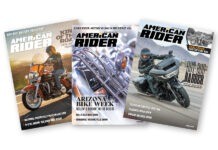This magnificent anachronism just showed up at California Harley-Davidson some weeks ago. The first thing most folks do when they see it is wonder what the hell it is… the second is ask why it’s at a motorcycle shop—any motorcycle shop—and the third (naturally) is try to figure out what they cost. No doubt there are more questions lingering in the back of the mind once confronted with a Morgan Tricar. After all, these things make Ferraris appear common (not to mention slightly boring), and aside from their many other unique charms have the appearance of old-school sports cars… missing a wheel. Let’s take a mental stroll around “The Mog” and attempt to get answers to all this and more; shall we?

First off… there are trikes, and there are Trikes
The Morgan trike (two wheels and the engine out front) predates all the rest, starting with the first back in 1909 called the Morgan Runabout, and from day one it was the best. Designed by Englishman H.F.S. Morgan, they were originally intended to sidestep some stupid British taxation law on cars of the time—by the simple expedient of losing one wheel. Thus, a Morgan and its competitors of the period were not “real” cars and did not pay the exorbitant fees most Brits were stuck with, if they could afford a car in the first place. (Doesn’t hurt to recall that back then the most popular car was the Model T Ford.) Ol’ H.F.S. had designed one of the first independent front suspensions (IFS) and used it to great advantage on his Tricar. Sure the Morgan was basic, as most cars back then were, but because of the suspension and the light weight, it didn’t take long to figure out that these tiny rule-beaters were also world-beaters… as sports cars! Quick, agile and major fun—on the cheap, no less. For over 40 years the cognoscenti reveled in the capabilities of these unique vehicles. Then, after the Second World War, the weird car tax was rescinded and since Morgan had begun building cars in 1936, these unique trikes were resigned to history by 1952.

Flash-forward to about 2010 when Charles Morgan, great grandson of H.F.S. and at the time still in charge of the business his ancestor created (the only family-owned car company in the world), remembered just how terrific the trikes had been when he stumbled onto an outfit in Seattle, Washington, building nearly the same thing using Harley Twin Cam engines and updated IFS. The story goes a little like this: Pete Larsen and wife Patty Billings had opened Liberty Sidecars (like the one in the movie Wild Hogs) in 1990. Long an admirer of the Mog Tricars, he decided to build a tribute/replica in case anyone might want one. They turned out pretty damn nice, although pretty damned undiscovered, as well. Then, one day the phone rang and Mr. Morgan, who just happened to be in town, asked to stop by. Pete was understandably a little freaked, but in the end Charles was duly impressed and a deal was struck. Forget the details; the fact is, a couple of years later in 2012, the Morgan 3 Wheeler was born again for the 21st Century!

It’s not how fast it goes—it’s how it goes fast!

Still a rule-beater (since none of these new-fangled “passive” automotive “safety standards” apply) the new Mog has no airbags, no bumpers, no frills and no baggage to hold it back. It remains what it always was in its soul: a unique expression of a serious pavement gobbler. (Consider this: a 200-mph supercar is basically useless beyond bragging rights in 70-mph, traffic-clogged America. A Morgan 3, on the other hand, can be flogged constantly within those same real-world parameters. It will not disappoint, either, since it’s as quick as any other car to any speed up to and beyond limits as we know them. This is not to say the little buggers aren’t a wicked “track days” weapon, either, as it’ll also whip the ass of almost any vehicle around any corner you’d care to try… and more!) In short, not without reason are Morgans (both three- and four-wheeled) often referred to as “the first and last of the real sports cars.” There is “hair shirt” purity in what these vehicles are and do, and that makes them extremely attractive to the few who “get it.” Being neither motorcycle nor car they are obviously not for everyone, yet I, for one, am glad to see them back!

Getting back to what this one was doing at California Harley-Davidson is, in part, evidence of that inexplicable desirability. You see, this particular Mog belongs to a business(man?) from eastern parts of the world, and after a brief stay in our parts, needed some disassembly before it could continue its journey back to its place of origin… England. Apparently it is cheaper to ship parts than a complete car, so the boys in the back room at California Harley were tasked with taking the engine, front wheels and some other bits off it prior to shipment. Since it was not licensed and could not be driven on public roads, “test” rides (graciously encouraged by the owner) were limited to some quick blasts around the parking lot by Eric Loyola, the dealership’s service manager. I got video and vicarious thrills out the wazoo, then the project was turned over to Lyle the technician with some spiritual support and a couple of valuable tech tips from Tony the tech at Morgan West in Santa Monica. (Yes, you can buy these trikes in this country, believe it or not.)
In the course of disassembling this tiny terror, I felt even more attracted to the Mog, not least by virtue of engine choice—namely that big S&S X-Wedge hung out front.

Beautiful and badass all at once, EPA “clean,” making monster torque and more horsepower than my old Toyota, yet hauling around less mass than a Harley Tri-Glide, you begin to understand that with a power-to-weight ratio in the same neighborhood as modern muscle cars, the Morgan 3 is no toy. In fact, the closer you look the more there is to appreciate in the particulars of this thing—from the way the wire wheels are laced, to the brakes and even how the trick “transmission adaptor” (bell housing) is used to harness the Miata 5-speed. I felt privileged just to see one in the flesh (most of us never will) and to look long and hard at the latest and greatest embodiment of a concept tested and proved generations before we were born… and still formidable in its genius today. Nowhere near perfect, as a fact, but maybe even more loveable for that, its capabilities, individuality and yes, damn it… character!





















I have been looking hard for the manufacturer of these V2 to Mazda adaptors. Do you have any leads?